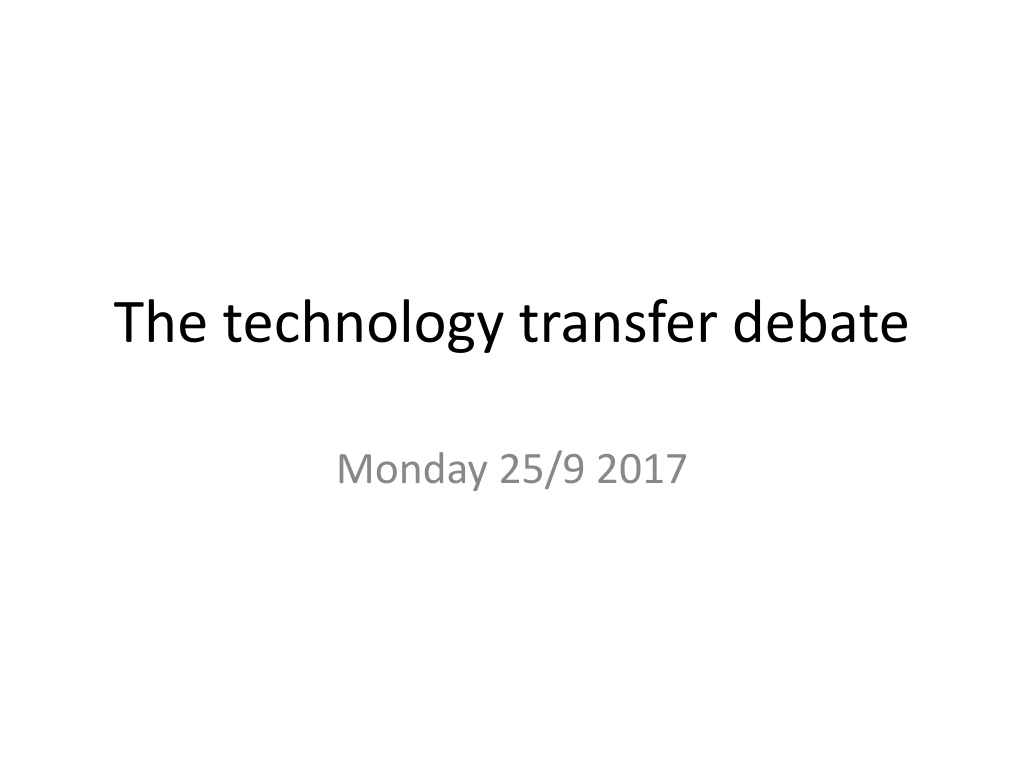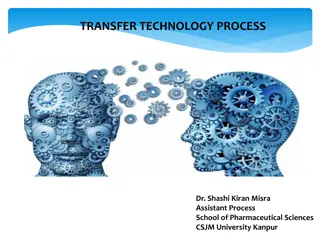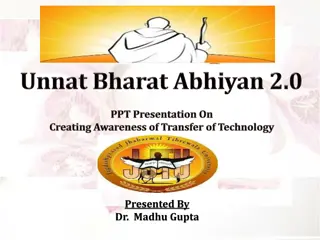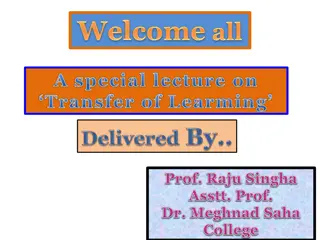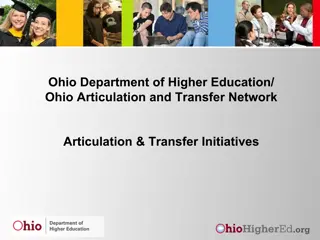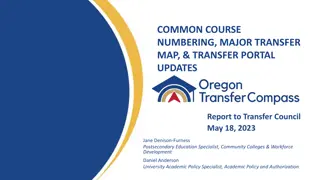Exploring Technology Transfer in International Development
Delve into the nuances of technology transfer and translation in the context of international development, shedding light on historical models, challenges, and successes. Understand the importance of circulating knowledge and managing design-actuality gaps. Explore the dynamics of ICT transfer from developed to developing countries, enabled by globalized systems.
Download Presentation

Please find below an Image/Link to download the presentation.
The content on the website is provided AS IS for your information and personal use only. It may not be sold, licensed, or shared on other websites without obtaining consent from the author. Download presentation by click this link. If you encounter any issues during the download, it is possible that the publisher has removed the file from their server.
E N D
Presentation Transcript
The technology transfer debate Monday 25/9 2017
Technology transfer outline How to approach the readings Background; why is this important Historical models explaining technology diffusion Understanding it better: Technology translation and other variants Success and failures. Challenges of design-actuality gaps. Design from nowhere Translations go both ways: the case of DHIS2
Guide to the readings Main narrative is from Nhampossa s thesis Chapter 2 nicely summarize discourses around technology transfer and translation Chapter 6 presents more in-depth on translation, strategies to manage it etc. Heeks: Presents a reasonable framework to understand aspects of sustainability. Design-actuality gaps Recommended readings Suchman: technology use is re-contextualization of technologies designed from nowhere Laet and Mol: very nicely written! Shows translations (assembling of networks) through the concept of fluidity. Also relevant for frugal technologies session Braa et al: technology learning. No tech transfer without knowledge transfer, and knowledge creation Sahay et al: circulating translations. Deals with technology translations between multiple locales. Relevant for understanding DHIS2 and implementations in countries
Background Technology transfer, in a wide sense, means transferring technology from originator/group, to wider dissemination. Can be from universities to private sector, from large businesses to small ones, from government to business, across borders, etc. In our case, it is usually in addition seen as transferring from developed country to developing . International development has been, and continues to be, focused on moving/developing technology from one context to another From early days of international development Agricultural machinery. Some industrialization (perhaps more in the Soviet camp?) A very common theme also in ICT4D, almost by definition ICT (from developed country) 4 D (in developing country)
Why transfer of ICTs from developed to developing countries (summary in Heeks) Economics of innovation: domination of industrialized countries research and development Economics of business: industrialized-country businesses able to invest more and earlier in ICT Economics and politics of aid: flow of resources and artefacts from developed to developing Belief in superiority of imported items All of the above enabled and strengthened by globalization: carried ideas and systems from developed to developing
Billions of $ going into technology transfer , led by development agencies http://www.who.int/phi/programme_technology_transfer/en/ http://www.worldbank.org/projects/P101928/health-sector-technology-transfer-institutional- reform?lang=en&tab=overview https://www.usaid.gov/ghana/news-information/press-releases/official-launch-feed-future-usaid- agriculture-technology IT is seen as a key tool in achieving [economic growth], and becomes part of a technically rational and technologically determinist agenda that focuses on the digital divide, on eDevelopment, and on IT infrastructure (Wilson & Heeks, 2000). Question 1: How is this seen from the various perspectives on development (from lecture 1)? Question 2: How do we transfer technology?
Historical models Rogers Diffusion of Technology TAM Critiques, and the realization that better explanations are needed
Diffusion of technology Rogers (1983) Focus on individuals ( early adopters , laggards ) Does not deal with social systems in which the diffusion takes place Critiqued for failing to account for complex technological innovation (ICTs). Technology as material object
Technology Acceptance Model (TAM) (Davis et al 1989) Builds on the ideas of, among others, Rogers Tailored to the context of ICT, designed to predicts ICT acceptance Perceived usefulness Perceived ease of use
Limitations of the models Diffusion of technology model and TAM would work well for facebook Suggested extension of the models (indicate they are not very precise) Endorsement of top management Technological culturation Accessibility Exposure to ICT (computer literacy) Perceived socio economic prospects ++
Critique of TAM (summarized by Nhampossa) Considering the characteristics of the technology itself Technology is black-boxed. Are they all the same? TAMs applicability to large, complex and interconnected systems remains questionable Socio-technical mismatch All the suggestions in previous slide really say that context matter When context/culture is considered, it is reduced to a limited set of variables, that are assumed measurable and standardized. A focus on voluntary use situations Perhaps useful for individuals Ignore the socio-political realities of organizations (UiO and microsoft exchange , MS Outlook for email) Snapshot instead of process perspective ICT adoption is not phenomena easily understood in snapshots Process perspectives needed (why did Johan adopted Outlook just recently?)
Introducing Technology Translation Need a broader view of technology Socio-technical Culture Organizations, institutions Language In short, context matters Originally from ANT, the concept of translation has seen wide use in terms of explaining how, why, and what happens when technology is transferred
Akrichs example (1992): There is no such thing as technology transfer A wood waste machine is transferred from Sweden to Nicaragua The social and technical relations (actor networks) around it are different, and start to change: Little wood in Nicaragua, forests held by rebels. Can t use rice waste. But cotton waste works! How to collect it? Machine from Sudan works ok. Another machine is built to harvest also waste under ground. But cotton waste only available a short period each year. Warehouses built! Then, Amphiserus Cornutu! The Sudanese machine have to be modified to compact the waste more. And so on .. The network in Nicaragua is different from the one in Sweden. Technology is passed from hand to hand: a series of small translations. Also the technology is translated.
Technology Translation Clarification: In ANT, technology also has agency (the power to act, to influence, to impose, to play a role). Think of how facebook rule you all Technology transfer should be seen as an outcome of how actors translate the interests of others so that they become aligned in the complex heterogeneous network of human and non-human actors (Nhampossa) What does he mean? With this perspective, effectiveness of technology transfer process is dependent on how the actor network is created and strengthened over time
How the translation perspective addresses some of the critiques of TAM Technology treated as black box Characteristics of technology important, how they shape and are shaped by socio-technical networks Technology transfer is one big step from North to South Technology translation focus on small incremental steps of co-adaptation between actors ( users and technology ) Socio-technical mismatch Translation perspective emphasize the socio-technical nature of any system. Translation processes include technology, politics, culture, institutions, history etc. Diffusion of technology is measured in terms of rate of adoption Translation perspective instead focus on stability of network, and alignment of interests. Individuals are treated as part of the network Diffusion perspective ignores challenges of scaling and sustaining over time In translation perspective, scaling and sustainability are core concerns.
Cultivating sustainable networks Means what? Examples of sustainable networks? HISP Uganda?
Heeks (2002) Looks at reasons for failures of information systems in developing countries Partial failure, total failure, etc.. Sustainability failure, particularly affecting DC Initially succeeding, but then falling apart End of funding When key staff quit When senior-level champions move on 1/5 to IS projects in developed countries are total failures 1/3 to 3/5 fall in the partial failure category Failure rates in DC might be (considerably) higher
Design-actuality gaps With technology transfer, the gaps are typically large Extreme cases when technology is designed within and for an industrialized country setting, and transferred to a developing country context Example: introduction of field health information system in Philippines, designed according to an American model assuming the presence of skilled programmers, skilled project managers, a sound technological infrastructure, and a need for outputs like those in an American health-care organization Even when efforts to develop an information system specifically for a developing country organization, there can be similar problems. Industrialized country consultants, IT vendords, aid donors etc. If it works for us, it will work for you . Even if they try, their poor understanding of the DC conditions will lead to gaps
How to limit gaps Actuality improvisation: changing the local actuality to make it closer to the IS design Design improvisation: changing the (often imported) IS design to make it closer to DC user actuality These improvisations should be locally situated How does this compare with translations?
Complementing views Fluidity as concept to understand attachment and detachment The need for learning Designer/user relationships. Design from nowhere, detached intimacy, located accountability Non-linearity of transfer and translation; circulating translations
The Zimbabwe Bush Pump type B Introduce Fluidity instead of networks: an object that isn t too rigorously bounded, that doesn t impose itself but tries to serve, that is adaptable, flexible and responsive in short, a fluid object may well prove to be stronger than one which is firm High interpretive flexibility Heeks point about local improvisation? Steel and wood. Locally replacable parts How does this relate to translation?
Technology learning (Braa et al) Not only will have to learn to use the technology, but must learn to be able to catch up with the industrialized countries Additional point: ICT development should be sheltered from international competition. Need to develop capacity themselves Heeks point about developing in and for DC: who will develop this? The people who know the context and assumptions
Suchmans Located acountabilities in technology production Pointing to three contrasting positions for design: Design from nowhere: A view that designers can make commodified technologies detached from any context Led to a rise of intermediaries (trying to make the system fit) Detached intimacy A cadre of developers turn back towards themselves. You can make a career only engaging with likeminded Located accountability We see the world from our own (limited) location We are responsible for creating collective knowledge about localities of both development and use What are the implications for technology transfer ?
Pointing to some possible implications for technology production Understanding technology use as recontextualization of technologies designed another place (similar to translation) Accepting the limited power of any actors or artifacts to control technology production/use (fluidity, networks)
Circulating translations Stresses the need for learning and local adaptations, or translations. Translations also affect what is transferred (software) With digital artefacts (software, written documents), these translations can easily travel further, leading to further translations in other contexts. The global and the local mutually reinforce each other What would DHIS2 be like if it had only been implemented in one country? Design from nowhere? Design from everywhere?
Nhampossas view of technology translation revisited Flexibility Design improvisation Fluidity Design-actuality gaps Circulating translations Technology learning Creating networks, aligning interests
Take-away points Transfer as translation Focus on the process; small-step incremental cultivation of networks. Transferred technologies change their new context, and are changed themselves. Flexible, improvisable, fluid, technologies make design-actuality gaps less dangerous. Allow easier recontextualization Learning the technology, and how to develop it, is important Translations circulate. We live in a global world, it influences us
